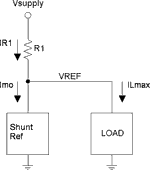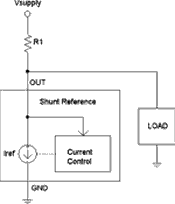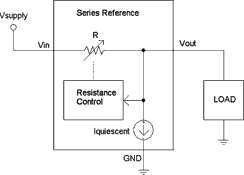
This article describes the main types of IC voltage reference (series and shunt), their advantages and disadvantages, and how to choose between them. You should decide which type is best for your application before starting to compare the available devices.
Series reference
A series reference has three terminals: Vin, Vout, and GND. Though similar in concept to a linear voltage regulator, it is designed for lower current and higher accuracy. A series reference operates in series with the load (Figure 1), and can be regarded as a voltage-controlled resistance between the Vin and Vout terminals.

It regulates by adjusting its internal resistance such that Vin minus the drop across the internal resistance equals the reference voltage at Vout. Because current flow is necessary to generate a voltage drop, the device draws a small quiescent current to ensure regulation when the load is removed. Series references have the following characteristics:
* The power supply voltage (Vcc) must be high enough to allow a voltage drop across the internal resistance, but not high enough to damage the reference IC.
* The IC and its package must handle power dissipation in the series pass element.
* With no load current, the only source of power dissipation is the reference quiescent current.
* Series references generally have a better initial tolerance and temperature coefficient than do shunt references.
Design equations for the series reference
A series reference design is fairly easy. Just make sure the input voltage and power dissipation are within the maximums specified for the IC:
P_SER = (Vsup - Vref)IL + (Vsup x Iq).
For a series reference, the worst-case power dissipation occurs for maximum power supply voltage and maximum load:
WC_P_SER = (Vmax - Vref)ILmax + (Vmax x Iq),
where:
P_SER = power in series reference
Vsup = power supply voltage
Vref = reference output voltage
IL = load current
Iq = reference quiescent current
WC_P_SER = worst-case power in series reference
Vmax = max power supply voltage
ILmax = max load current.
Shunt reference
A shunt reference has two terminals, OUT and GND. It is similar in concept to a zener diode, but has much better specifications. Like a zener diode, it requires an external resistor and operates in parallel with its load (Figure 2).

It can be regarded as a voltage-controlled current source between the OUT and GND terminals. Regulation is achieved by adjusting the current level so that Vsupply minus the drop across R1 equals the reference voltage at OUT. As an alternative description, the shunt reference maintains a constant voltage at OUT by forcing the sum of load current and current through the reference to be constant. Shunt references have these characteristics:
* Given an R1 appropriately sized for power dissipation, the shunt reference imposes no limit on the maximum power supply voltage.
* The power supply delivers the same maximum current regardless of load. Supply current flows through load and reference, dropping just the right voltage across R1 to maintain the OUT reference voltage.
* As a simple 2-terminal device, the shunt regulator can be used in novel circuit configurations such as negative regulators, floating regulators, clipping circuits, and limiting circuits.
* Shunt references generally have lower operating currents than do series references.
Design equations for the shunt reference
A shunt reference design is somewhat more difficult because one must calculate the external resistor value. That value (R1) must ensure that its voltage drop due to reference and load currents equals the difference between supply voltage and reference voltage. R1 must be calculated at minimum supply voltage and maximum load current to ensure operation under this worst-case condition. The following equations calculate the value and power dissipation of R1, and power dissipation in the shunt reference (Figure 3).

R1 = (Vmin - Vref)/(Imo + ILmax).
The current and power dissipation in R1 depend only on the power supply voltage. Load current has no effect, because the sum of currents through load and reference is constant:
I_R1 = (Vsup - Vref)/R1
P_R1 = (Vsup - Vref)²/R1
P_SHNT = Vref(Imo + I_R1 - IL).
The worst-case conditions are maximum power supply voltage and no load:
WC_I_ R1 = (Vmax - Vref)/R1
WC_P_R1 = (Vmax - Vref)²/R1
WC_P_SHNT = Vref(Imo + WC_I_R1),
or
WC_P_SHNT = Vref(Imo + (Vmax - Vref)/R1),
where:
R1 = external resistor
I_R1 = current flowing through R1
P_R1 = power dissipation in R1
P_SHNT = power dissipation in shunt reference
Vmin = min power supply voltage
Vmax = max power supply voltage
Vref = reference output voltage
Imo = reference minimum operating current
ILmax = max load current
WC_I_ R1 = worst-case current through R1
WC_P_R1 = worst case power dissipation in R1
WC_P_SHNT = worst case power dissipation in shunt reference.
Choosing a reference
Now that you understand the differences between a series and shunt reference, the next step is to determine which is better for your application. The best way to make sure you are getting a suitable part is to consider both the series and shunt types. After doing the design calculations for each, the preferred type should be obvious. Here are some rules of thumb:
* If you need better than 0,1% initial accuracy and a 25 ppm temperature coefficient, you should probably select a series reference.
* If you want the lowest operating current, consider a shunt reference.
* Be careful when combining a shunt reference with a widely-varying power supply or load. Be sure to calculate the expected power dissipation, which can be much higher than that of an equivalent series reference. (See examples, which follow.)
* For power supply voltages higher than 40 V, a shunt reference may be your only choice.
* Consider shunt references when building a negative reference, floating reference, clipping circuit, or limiting circuit.
Example 1 - Low voltage, steady load: In this portable application, the most critical parameter is low power dissipation. Here are the specifications:
Vmax = 3,6 V
Vmin = 3,0 V
Vref = 2,5 V
ILmax = 1 mA.
We narrowed the search to two parts:
* MAX6029 series reference:
Iq = 5,75 mA
WC_P_SER = (Vmax - Vref)ILmax + (Vmax x Iq)
WC_P_SER = (3,6 V - 2,5 V)1 mA + (3,6 V x 5,75 mA) = 21,8 mW.
* MAX6008 shunt reference:
Imo = 1 mA
R1 = (Vmin - Vref)/(Imo + ILmax)
R1 = (3,0 V-2,5 V)/(1 μA + 1 μA) = 250 kΩ
WC_I_ R1 = (Vmax - Vref)/R1
WC_I_R1 = (3,6 V-2,5 V)/250 kΩ = 4,4 μA
WC_P_R1 = (Vmax - Vref)²/R1
WC_P_R1 = (3,6 V-2,5 V)²/250 kΩ = 4,84 μW
WC_P_SHNT = Vref(Imo + (Vmax - Vref)/R1)
WC_P_SHNT = 2,5 V(1 µA + (3,6 V-2,5 V)/250 kΩ) = 13,5 μW.
Total power dissipation is therefore 18,3 μW. The preferred part for this application is thus the MAX6008 shunt reference, because its power dissipation is 18,3 μW (vs. 21,8 μW for the MAX6029 series reference).
This example illustrates the large effect of power-supply variation on design. Initially it appeared that the shunt reference had a huge advantage with its 1 μA minimum operating current, but to guarantee operation under worst-case conditions the operating current had to be increased to 4,4 μA. Any variation in the power-supply voltage greater than specified in this case (3,0 V to 3,6 V) would call for the use of a series reference.
Example 2: Low voltage, varying load: This example is similar to Example 1, but with a small change in the specifications. Instead of a steady 1 μA load, this load alternately draws 1 μA for 99 miIliseconds, then 1 mA for 1 millisecond:
Vmax = 3,6 V
Vmin = 3,0 V
Vref = 2,5 V
ILmax = 1 mA (1% of time)
ILmin = 1 μA (99% of time)
We consider the same two parts:
* MAX6029 series reference
Iq = 5,75 μA
C_P_SER = (Vmax - Vref)ILmax + (Vmax X Iq)
WC_P_SER (1 mA IL) = (3,6 V-2,5 V)1 mA + (3,6 V x 5,75 μA) = 1,12 mW (1% of time)
WC_P_SER (1 μA IL) = (3,6 V-2,5 V)1 μA + (3,6 V X 5,75 μA) = 21,8 μW (99% of time)
Average power dissipation = 1,12 mW x 1% + 21,8 μW x 99% = 32,78 μW.
* MAX6008 shunt reference
Imo = 1 µA
R1 = (Vmin - Vref)/(Imo + ILmax)
R1 = (3,0-2,5)/(1 μA + 1 mA) = 499
For ILoad = 1 μA:
WC_P_R1 = (Vmax - Vref)²/R1
WC_P_R1 = (3,6-2,5)²/499 = 2,42 μW (1% of time)
P_SHNT = Vref(Imo + I_R1 - IL)
P_SHNT = 2,5 V(1 μA + 1 mA - 1 mA) = 2,5 μW (1% of time)
For ILoad = 1 mA:
WC_P_R1 = (Vmax - Vref)²/R1
WC_P_R1 = (3,6-2,5)²/499 = 2,42 mW (99% of time)
P_SHNT = Vref(Imo + I_R1 - IL)
P_SHNT = 2,5 V(1 μA + 1 mA - 1 μA) = 2,5 mW (99% of time),
Average power dissipation is:
2,42 mW x 1% + 2,5 μW x 1% + 2,42 mW x 99% + 2,5 mW x 99% = 4,895 mW.
As can be seen, the average power dissipation in the shunt reference is over 100 times higher than in the series reference. For applications in which the load current varies widely, a series reference is usually the better choice.
| Tel: | +27 11 608 0070 |
| Email: | [email protected] |
| www: | www.cstelectronics.co.za |
| Articles: | More information and articles about CST Electronics |
| Tel: | +27 11 458 9000 |
| Email: | [email protected] |
| www: | www.electrocomp.co.za |
| Articles: | More information and articles about Electrocomp |

© Technews Publishing (Pty) Ltd | All Rights Reserved